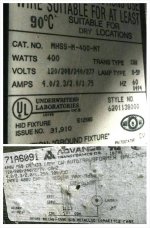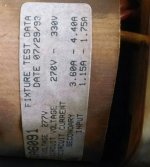solace
Active member
Hey folks, I have this bulky 400W MH balast with a multi-vapor bulb I use currently.
Well I got tired of that bulky attribute so separated the socket from the ballast by unscrewing a few things.... Then snipping the wire. I went out and bought similar wiring except it was plastic shielded ather than insulated and meshed. Hooked it all up so I had an extra 3 feet or so now.
But nothing happened when I turned it on. So I went out and got more wire of another type (still copper like the other and original), thermal insulated wiring.
The fixture has thicker gauged individual wire strands, but overall combined the gauge is of the whole wire is only like 14-16. The ones I bought, have an overall thicker gauge when combined, but smaller individual wires. Could this be it?
I thought maybe it could be the hookup order of the two wires so I swapped them, still nothing.
Maybe its my connectors that link the two wires? Maybe the end crimp nodes that screw into the socket fixture of the bulb?
Is the distance of wire having an effect? I tested this and shortened it all the way back while still using both the old and new wire together.... And still nothing.
I have not reconnected it back up yet like how it was from the get go when it DID turn on.
Please help folks!
Well I got tired of that bulky attribute so separated the socket from the ballast by unscrewing a few things.... Then snipping the wire. I went out and bought similar wiring except it was plastic shielded ather than insulated and meshed. Hooked it all up so I had an extra 3 feet or so now.
But nothing happened when I turned it on. So I went out and got more wire of another type (still copper like the other and original), thermal insulated wiring.
The fixture has thicker gauged individual wire strands, but overall combined the gauge is of the whole wire is only like 14-16. The ones I bought, have an overall thicker gauge when combined, but smaller individual wires. Could this be it?
I thought maybe it could be the hookup order of the two wires so I swapped them, still nothing.
Maybe its my connectors that link the two wires? Maybe the end crimp nodes that screw into the socket fixture of the bulb?
Is the distance of wire having an effect? I tested this and shortened it all the way back while still using both the old and new wire together.... And still nothing.
I have not reconnected it back up yet like how it was from the get go when it DID turn on.
Please help folks!





